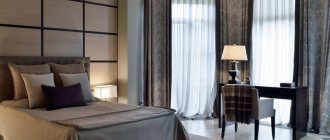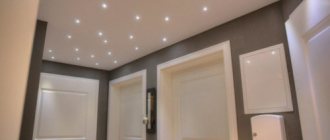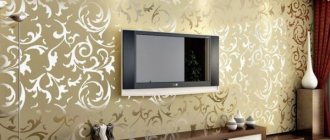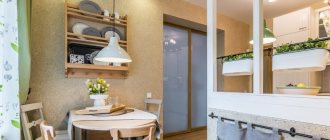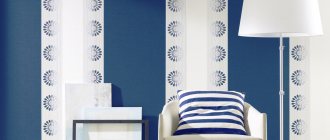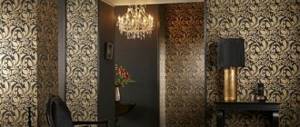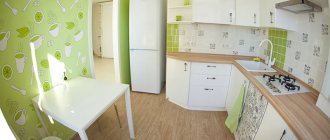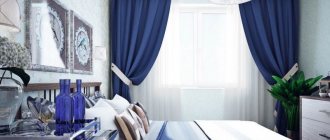Repair is an unpredictable process; often people start doing one thing, but change their minds. A situation familiar to everyone: you have chosen and pasted wallpaper, but looking at it, you realize that everything seems boring and uninteresting. There is no zest that can bring contrast or, conversely, harmony. This doesn't mean you have to remove the wallpaper. In this state of affairs, the most optimal thing is wallpaper borders. Before choosing and purchasing them, it is worth finding out the principle of fixation and what is available on the market.
Characteristic
A border for wallpaper can be called a universal finishing material; in addition, in stores it is called edging, frieze, edging. All this will allow you to easily change the design and add interesting notes. There is an opinion that such an update is a thing of the past. But it is wrong, because you need to know how to fit it into the overall repair. After all, the edging has a large assortment and unusual color solutions.
What are his external characteristics? The product is a strip of different widths. Usually sold in rolls. But making a choice is not as difficult as it seems. In addition, in stores there is already a prepared edging for various wallpapers, so you don’t even need to spend a lot of time selecting. It is not uncommon for the wallpaper to be already on the wall, but the frieze has not been selected. In this case, you should carefully consider the selection. Stores may have the following wallpaper borders:
- Paper. It's a basic look and easy to stick on and remove. If you do not fix it carefully to the wall, the materials will easily tear and get wet. This is one of the cheapest options, but the service life is minimal.
- Vinyl. This is a more reliable type. They do not fade when exposed to sunlight, they are durable, so they have a longer service life. Can be washed if necessary. Due to these characteristics, this wallpaper border is found in bathrooms and kitchens.
- Acrylic. No less durable option. They are often compared to vinyl, but at the same time the price indicator is lower.
- Textile. This frieze has its own characteristics - the presence of two layers. The first is paper as a base, after which a beautiful layer is applied here, which serves as decoration. Velor is often used, but there are a lot of disadvantages. Thus, the material does not withstand mechanical stress and moisture. Dust settles quickly and can be damaged by animals. It is difficult to care for this type of tape because wet cleaning is prohibited.
- Fiberglass curb. This is one of the most durable types. It is this finishing material that will serve for a long period of time without reacting to external stimuli. It is unique and suitable for any room, but the price is higher than all previous ones.
If you don’t need a clearly defined contrast, then you should choose a decorative border for wallpaper made of the same material as the main covering. For example, if the wall has acrylic wallpaper with silk-screen printing, then using paper borders is at least inappropriate - the whole chic look will be ruined.
We can say for sure that sometimes a frieze helps to remove defects, transitions, and create zoning. But do not forget that this is only interior decoration.
Wallpaper border: which one to choose?
However, they have a significant disadvantage - the paper edging cannot be washed, it can only be cleaned of dust, and besides, it is short-lived, after two or three years it may lose its “marketable” appearance.
According to their purpose, borders are divided into those intended for the living room, bedroom, kitchen, bathroom, and there are also special borders for children. All these types of edgings differ in pattern, color, shape and material. Obviously, the edging for the living room should look the most solid and respectable. Delicate, pastel shades and floral patterns are suitable for the bedroom. Kitchen edging today is sold with images of vegetables and fruits. Examples of stylish interiors with a border are in the photo.
A children's wallpaper border is usually a border made in bright colors, it depicts cartoon and comic characters, cute animals, flowers and the like. When choosing edging for a children's room, it is important to focus not only on the color scheme of the interior, the type of wallpaper and your own preferences. The most important thing is the safety of all materials. It is necessary to purchase borders, wallpaper and everything else for the children's room in specialized stores, from manufacturers who are worthy of trust. You should definitely ask sellers to present the necessary hygiene certificates for all products.
Edging selection process
Wallpaper is the first thing you need to focus on when choosing an edging. Of course, you need to choose the same type of edging as the wallpaper you plan to decorate the walls with. If the wallpaper is made of vinyl, you will need the same edging; it is permissible to match the paper rolls with textile or vinyl borders - with these, even simple, inexpensive wallpaper will look more impressive.
The color of the decorative element is extremely important - it should either be contrasting (like the entire interior) or as close as possible to the color of the main decorative material. There is one more rule - if the wallpaper is plain, you should choose a border with a print or an active pattern, but if the wallpaper is decorated with patterns, you will need a plain border. Only in very rare, exceptional cases can you choose an edging with a pattern that matches the wallpaper pattern. But such a selection requires skill, a sense of style and good taste.
It can be difficult to choose a border for wallpaper, but this is exactly the case when it makes sense to work hard to end up with a perfect and complete interior!
It is quite acceptable to wallpaper a variety of surfaces. The base must be completely dry, smooth and level, free from dust and other contaminants. On a damp base, wallpaper adhesives will swell or even rot, causing stains to appear on the wallpaper. In addition, wet and rotting wallpaper glue smells quite unpleasant. You should not stick wallpaper to glossy surfaces, as they will not adhere to them anyway.
If wallpaper is glued to rough surfaces, then there is a fairly high probability that it will soon come off. To prevent this from happening, plastered walls are covered with a layer of putty. For this purpose, semi-oil putties are most suitable, the basis of which is chalk sifted through a fine sieve. Before applying the putty, the surface is primed, for which vitriol primer is best suited. The putty is applied in one or two layers. In this case, the top layer is carefully leveled and cleaned with fine-grained sandpaper.
Surfaces covered with plaster must be inspected very carefully. If there is a coating of lime or glue on them, it should be removed completely, otherwise the wallpaper will not adhere well. After removing the stain, the surface must be thoroughly wiped with a wet, hard cloth.
If there are cracks in the plaster, they are widened and all loose plaster is removed. The resulting surface is thoroughly moistened with water and covered with cement-sand mortar. The seams are rubbed so that they are flush with the rest of the surface. Upon completion of the repair, the surface is thoroughly dried, treated with a wooden block, which will help make it more even, and lastly cleaned of dust. You need to remember that all seams and roughness will be very clearly visible on the surface of the wallpaper, especially on paper.
When preparing concrete or gypsum slag surfaces, they are first inspected, all existing irregularities are cut down, covered with mortar and rubbed. It is not advisable to use gypsum for these purposes, since when it hardens it tends to expand, so a raised area may form on the surface, which will be very noticeable on the wallpaper.
Wooden surfaces, as well as surfaces made from fibreboard or particleboard, plywood or dry plaster, must be cleaned of dust. In places where the plates are joined to each other, they can protrude, so they are treated with sandpaper, covered with a layer of drying oil, and putty. It is acceptable to simply seal the cracks with paper strips or gauze. The heads of the nails are sunk into the solid slab or plywood to a depth of 1 mm, covered with a layer of drying oil and putty.
It must be remembered that sheets of dry plaster have two sides - smooth and rough. They should be attached to the wall with the rough side. If they have already been nailed in reverse, then the rough surface is covered with a primer, onto which a layer of putty is then applied.
All wooden surfaces are covered with cardboard before wallpapering.
Surfaces already covered with old wallpaper are prepared in a variety of ways. To remove the wallpaper, they are moistened with warm water and left for 10 minutes, after which the wallpaper should easily come off the base. In some cases, the wallpaper may not be removed. This can be done if the wallpaper being glued has a lower density compared to the existing wallpaper.
Before wallpapering walls, you need to glue them, that is, cover the base with the same composition that will be used to glue the wallpaper. This is done using a swing brush.
Location
Depending on where the material will be located, they are divided into:
- Border for children's wallpaper. This is the most understandable option, because the manufacturer applies toys, animals, etc. to the surface.
- Border in the living room. The main advantage is the rich appearance. At the same time, flowers, stripes, ornaments, etc. are often depicted. And often, by adding such a border tape, the design style of any of the rooms is highlighted.
- Border for the kitchen or dining room. The corresponding elements can also be depicted here - berries, any food, sweets, etc. Here the border is always an accent, for example, of a dining area or window.
Wallpaper borders: self-adhesive and other types of materials
Today, many manufacturers make wallpaper borders with identical patterns, but they differ in size and material.
A large selection of modern wallpapers often makes it difficult to choose. Our material will help you not to get confused and make the right decision:
Below are the types of borders for walls, which are divided:
- To size.
The width of the curb may vary significantly. It varies from a few cm to a meter. A standard roll holds 5-10 meters of material. - By color.
Some products are plain, while others have designs. - By type of fastening.
There are self-adhesive borders - these are special borders on which a special adhesive substance is applied. Such products have a special protective film, so the material is easy to use even for a beginner. When gluing other models, it is enough to moisten the material with water (the glue is applied to them during production). Other types must be treated with glue intended for these purposes. - By texture.
Some products are smooth, while others have a variety of embossing. - According to external features.
There are simple borders for wallpaper (regular pattern or holographic pattern), as well as decorative models (lace or gilded). - By topic.
For a certain room (kitchen or children's room) in the house there are the most suitable models, with corresponding drawings.
In addition to the above characteristics, wallpaper borders differ in material.
Paper
They belong to the budget category and are easy to use. However, this material is short-lived and cannot be washed.
Vinyl
They are considered to be of higher quality, easy to clean and adhere to. Such decorative products will last for many years. This type of baguette is recommended for use in rooms with increased pollution (kitchen, bathroom or dressing room). They have a porous base, which allows the walls to “breathe”.
Acrylic
Borders made from this material are of high quality and have many positive characteristics. Here a special acrylic emulsion is applied to the surface of the strip.
How to combine it with wallpaper?
Having understood the assortment on the market, it is worth finding out the combination methods. The main advice for choosing is not to forget about the color and the presence of a pattern. There are not many options, but there are the most successful ones, thanks to which you get a complete picture of wall decoration:
- The same type of wallpaper and frieze with a pattern. One of the simple methods. Suitable for those who want to maintain elegance and at the same time add some zest. When the ornament is on a cutter, its width should be such that you can see what is depicted there. At the same time, pay attention to the shade. It must coincide with the main walls. This method dilutes the usual interior and makes it more unique. Suitable for large rooms where the emphasis is not on furniture. In a children's room, this method will also be appropriate and will add rainbow colors (since at an early age the child wants variety, changing the border tape is not so difficult and expensive).
- Wallpaper with a pattern and a plain border. Here the color scheme is something that is practically absent from the wallpaper. This approach helps eliminate oversaturation. Width doesn't matter. The only thing you need to know is that a narrow strip will get lost among large patterns. Gold and silver edgings look original.
- There is an ornament on the wallpaper, a pattern on the ribbon. This combination is interesting, but not worth the risk. If the ornament is incorrect, it will be too rich, all attention will be on the walls, and the rest will disappear from sight. In this position, the border is not wide and there are notes of a pattern from the wallpaper on it. Sometimes they make a general design and ornament. The only thing is that they choose a different direction. This makes it very interesting and original.
- The wallpaper is dark and light in combination with a frieze. Designers know how to play with colors, ultimately creating harmony and individuality. But light walls quickly get dirty, so this option uses darker colors underneath. And the joint is hidden behind self-adhesive wallpaper borders. In this case, the tape is selected with an ornament in the color of one of the wallpapers. Or the presence of drawings on the main canvas is complemented with a frieze of any shade. Visually this is a unique combination.
General points related to the border
- There is currently a fairly wide selection of this material on the market. A smart decision would be to choose the edging directly when purchasing wallpaper. As a rule, a competent seller will be able to offer you several options for decorating your canvas. Here it is important to decide in what style you want to decorate your home.
- You can select in different ways, in the first case you should focus on the color shade. For a calming atmosphere, use a tape of the same color as the wallpaper, but with a different shade. To add brightness and dynamism, you need to use opposite colors of the spectrum.
- The second method involves relying on a drawing. The design should be consistent with the ornament on the walls. It may differ in scale or color scheme, but it should still be similar.
Advice: do not make an overly bright edging, it will be very noticeable, and sometimes it can even irritate. This interior detail should emphasize beauty, but in no case be intrusive.
For what coatings is it used?
- If we talk about paper wallpaper, then this is for the most part an economical option; they are glued quickly and easily, but they do not last as long, often lose their luster and fade. The most you can do is wipe off the dust with a dry cloth.
- Vinyl sheets are considered the most stable; they are not afraid of almost anything
. They can be wiped with a damp sponge and even washed gently with gentle detergents. Vinyl is UV resistant and quite durable. You will get tired of them before they become unusable. - Textile tapes are a specific product, their price is quite high and such finishing is suitable only for an interior made in a certain style. Here you can often find two-level wallpaper, to separate which a special border or frieze is used.
- There are also tapes with acrylic coating; they are quite durable and beautiful, but their price is lower than that of vinyl. Another advantage is that acrylic is a breathable coating.
- An interesting effect can be obtained by using synthetic colorless borders
. They have a certain texture and are used in tandem with plain coatings for painting.
Where can I glue the tape?
- Wallpaper border tape can shade or separate. With low ceilings, it is better to put a narrow edging along the top and leave it at that. If you want to add some zest to the interior, then you should try to combine wallpaper of different colors, separating them with a border, but do not forget, the wider the tape, the lower the ceilings will appear, plus the tape is started either at the height of the window sill, or at 1/3 of the height of the wall . Otherwise, the ceiling will also drop significantly.
Important: when planning to assemble multi-colored or multi-textured canvases, you should take into account that there must be one material. If you use vinyl, then everything should be vinyl.
- As for the bottom edging, it is used extremely rarely and mostly to hide unevenly glued canvases.
The video in this article shows the general technique for working with wallpaper.
How to stick?
All types of wallpaper borders have their own gluing techniques. What does this include:
- Some are called self-adhesive. To do this, remove the protective tape, and underneath it the sticky layer. The material is quickly fixed.
- The reverse side already contains the required composition. It is moistened with water and the curb is fixed in place.
- But the main part of this addition is mounted like standard wallpaper using an adhesive. There is a special one on sale marked “for borders”.
Wide borders for wallpaper in the photo
Wide borders for wallpaper, as a rule, are designed to create contrast and a playful atmosphere in the interior, and therefore differ greatly in color from the wallpaper on which they are glued. Most often, wide wallpaper borders can be seen under the ceiling, although there are also more original ways of using them, for example, as a decorative vertical strip on the wall.
Also read: History of wallpaper - the most interesting facts
Recommendations
The majority of inexperienced people believe that the frieze is fixed on the wallpaper. But this method is suitable for paper ones. Otherwise, the bulge will be visible, which means the surface of the walls is being prepared. This is done in the same way as for wallpaper. Afterwards, markings are made, the required quantity is measured and the border tape is cut. The glue is made, then it sits for 15 minutes and work begins.
You should not immediately apply the composition to the entire perimeter. Also, the layer is not made too thick. Otherwise, the composition will come out and stain the wallpaper. Often the tape is fixed first, taking into account the evenness, and only after it is the guide for the wallpaper. You need to have a soft cloth on hand to remove excess glue.
The joints are pressed well so that they do not move away. If the border is used for windows or doors, then joints at an angle of 45 degrees look more beautiful.
